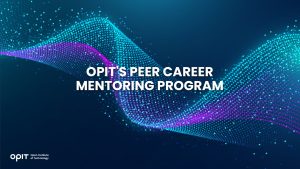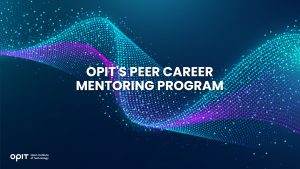

With great salaries, high market demand, and opportunities to work in an ever-growing industry, computer science represents an excellent career choice. The profession is a pivotal part of the modern digital landscape and includes work with big data, cloud computing, cybersecurity, and advanced IT services.
Due to being a highly desirable vocation, computer science is quite a competitive field. That’s why it’s essential to learn the basics about the profession, particularly what to expect from BSc Computer Science jobs and salary.
This article will serve as an overview of the job profile and share the most important details. If you’re asking “Is BSc Computer Science worth it,” the answer at a glance is: yes. Let’s take a deeper look at the subject and see why.
BSc Computer Science Salary per Month
Getting info about BSc Computer Science salary is relatively easy. And the data is quite impressive: An average computer scientist in Germany earns more than €3,700 monthly. In Denmark, the salary is over €4,800, while French computer scientists earn just shy of €4,200.
The above numbers describes the average income of all computer scientists. When it comes to BSc Computer Science jobs salary, the mean figure is somewhat lower, but still nothing to scoff at.
Work experience is a massive factor here, so the pay will be lower for BSc Computer Science jobs for freshers. Salary averages in those cases are in the range of €3,000-€3,800 on a monthly level.
Moving away from general averages, a bachelors in computer science salary can vary significantly depending on numerous factors. The following is an overview of the crucial elements that may determine how much this job pays.
Factors Affecting Monthly Earnings
Salaries for BSc Computer Science jobs change according to four common variables that influence wages in every profession:
- Location
- Company Size
- Experience
- Industry
1. Location
It’s not surprising that the same job pays differently depending on location. Certain states offer higher salaries for computer scientists, with Switzerland, Denmark, and Norway being the leaders.
On the other hand, the lowest-paying countries for this profession include Ukraine, Poland, and Russia. The differences are staggering, particularly between specific areas.
For instance, if you work as a BSc computer scientist in Switzerland, you’ll likely earn double compared to your colleagues in Finland or Ireland. But if you’re in Ukraine, your salary will be about 60% lower than the German counterpart.
It’s worth noting that higher salaries account for living costs, which are higher in areas that offer a better monthly pay.
Of course, remote work has opened up more opportunities. As a BSc computer scientist, you can live in a low-cost area but earn your pay in a high-salary company.
2. Company size
Company size impacts employee salaries in every walk of life. Working as a computer scientist in Apple or Adobe will pay more than doing the same job in a startup or a small business.
Furthermore, a smaller company might not have the budget to fill all of the necessary IT roles. In such cases, a single employee might perform multiple tasks, sometimes acting as a one-person department.
In other words, a job in a small company could mean not only a smaller paycheck, but more work, too.
3. Experience
The number of years spent in a certain profession usually determines salary height, and this is no different when it comes to computer science. A computer scientist with over two decades of experience will likely fulfill a senior role and may earn, on average, a third more than a beginner.
4. Industry
Salary averages for BSc computer scientists don’t vary too much across industries. The highest overall pays are in high-profile IT companies like Adobe.
Interestingly, the National Institute of Health has a better average pay range, although the top wages here are about a sixth lower than in Adobe. However, the lowest salary in the institute is higher than its counterpart in the tech giant.
Jobs & Salary for BSc Computer Science Graduates
A BSc Computer Science graduate may take on several common job roles, regardless of the industry. Let’s review some of the most widespread jobs for this profile.
1. Software Developer
The job of a software developer is precisely what it sounds like: developing apps for computers and mobile devices. In addition, software developers also test existing apps.
For these BSc in computer science jobs, salary averages are about €4,500 monthly. Counted among the best jobs in the market, the software developer position is often described as a rewarding profession with high job satisfaction.
2. Systems Analyst
A systems analyst is tasked with analyzing an existing computer system and coming up with ways to improve it. The profession is also known as a system architect.
On average, systems analysts earn around €3,800 per month. These professionals reportedly work in pleasant environments and under satisfactory conditions. Thus, it’s no wonder that working as a system analyst comes with a higher job satisfaction.
3. Network Administrator
Network administrators have a vital role in every company. They’re tasked with installing and maintaining computer networks, which are often the foundation of a business.
The average monthly pay of a network administrator is similar to a systems analyst’s, in the neighborhood of €3,700. This job comes with relatively low stress and ranks higher in terms of job satisfaction.
4. Database Administrator
The responsibilities of a database administrator include systematic data organization and ensuring easy access to the said data. The job has cybersecurity elements, as well.
Database administrators are, on average, paid similarly to software developers, i.e., about €4,600 per month. While pay satisfaction is high, professionals in this field report a relatively low career satisfaction.
5. IT Consultant
An IT consultant is involved in various IT-related roles. They often build the complete IT structure, resolve immediate issues, and provide crucial advice on IT use.
The average monthly pay for this profession is nearly €3,300. Although the salary is slightly lower than other computer science roles, IT consultants are overwhelmingly satisfied with their job positions.
Course Benefits of BSc Computer Science
Is BSc in Computer Science good as a career choice? Undoubtedly. But to start working such a lucrative and often satisfactory job, you’ll need to get educated in the field.
Here’s what you can look forward to when enlisting into a BSc Computer Science course.
Acquiring In-Demand Skills
One of the most important benefits of a BSc Computer Science course is that you’ll learn the essential skills of the profession:
- Working with the most in-demand programming languages
- Understanding computer algorithms and data structures
- Getting a grip on computer network architecture
- Learning how to manage different databases
Industry Relevance and Adaptability
A quality course for BSc Computer Science will give you industry-relevant skills. With a wider knowledge about computer science, you’ll be able to adapt to different roles and find your place in the market more easily.
Opportunities for Further Education and Specialization
Attaining a BSc in Computer Science will make you eligible for further academic progress. While you can find great work opportunities as a BSc, you’ll also have the option of continuing your studies towards a PhD or specializing for a specific branch of computer science.
If you’re interested in these venues of progress, there’s no need to question “is BSc Computer Science a good course.” For your purposes, it’s the best. Read on to find out what a typical course entails.
Course Duration and Structure
Job prospects for computer scientists look pretty appealing. But if you want to become a BSc Computer Science, how many years would you need to devote to studying?
These courses last for three years, usually encompassing six semesters. That’s not a very long time to become qualified for one of the most wanted professions. Better yet, there are fast-track options that last only two years.
Overview of Course Structure
Core subjects of BSc Computer Science courses differ from one term to the next. During the first term, you’ll learn about computer architectures and networks, the principles of programming and ICT, and technical English.
The second term contains web development, foundational math, OS introduction, data structure, and project management. The third term will introduce you to databases, cloud computing, AI, and business strategies. You’ll also delve deeper into programming paradigms here.
The fourth term deals with software engineering, machine learning, cybersecurity, digital marketing, and cloud development.
The fifth term is where you can choose between elective subjects:
- Cybersecurity
- Machine learning
- Application of complex networks
- Automated cloud computing
- Front-end programming
- AI ethics
- DevOps
The final term is reserved for your thesis project, which will serve as proof of the skills you’ve acquired so far.
It’s worth noting that the course can have a level of flexibility, allowing you to customize your schedule and select a particular curriculum. This may come in handy for working students and those who wish to pursue a specific path in the field.
Fresher’s Job Potential
Since computer science professionals are in high demand, the market has plenty of job opportunities for freshers. You’ll likely be able to find work as an application, network system, or software developer. Additionally, software engineer and IT support roles are widely available.
Industry leaders like IBM, Microsoft, and Google count among the top recruiters. However, landing a job with such giants won’t be straightforward. Here’s how to maximize your chances.
Tips for Securing a Job
1. Build a network
Finding the perfect job is often a matter of not only what, but who you know. Expanding your network might open up better opportunities.
2. Gain experience
The best way to launch a successful career is to build it up, so gaining initial experience will be crucial. You can start as an intern or an employee in a smaller company and work your way up from there. When looking for your first BSc Computer Science jobs for freshers, salary won’t be the main consideration.
3. Build a good portfolio
You’ll need a strong portfolio to progress in your computer science career. It’s often best to start small and progress to more high-profile jobs and demanding roles. When you submit your application to Google or Apple, you’ll want to have a CV full of great references.
4. Keep up with industry trends
The IT sector evolves and shifts very often. To make the most of your skills, keep expanding them according to the particular industry you’re working in.
Generally speaking, this last tip will relate to your overall career. Develop your skillset beyond the basics and keep learning. You’ll have an easier time growing the career you want.
Start a Rewarding Computer Science Career
With more than competitive salaries and enticing job opportunities, there’s little not to like about a career in computer science. A relatively small investment in time and effort can help you enter one of the most promising and rewarding job markets in the world.
If you’re ready to pursue a career in computer science, there’s no better time than today. Enlist in a quality course and start building for the future.
Related posts

Source:
- Raconteur, published on November 06th, 2025
Many firms have conducted successful Artificial Intelligence (AI) pilot projects, but scaling them across departments and workflows remains a challenge. Inference costs, data silos, talent gaps and poor alignment with business strategy are just some of the issues that leave organisations trapped in pilot purgatory. This inability to scale successful experiments means AI’s potential for improving enterprise efficiency, decision-making and innovation isn’t fully realised. So what’s the solution?
Although it’s not a magic bullet, an AI operating model is really the foundation for scaling pilot projects up to enterprise-wide deployments. Essentially it’s a structured framework that defines how the organisation develops, deploys and governs AI. By bringing together infrastructure, data, people, and governance in a flexible and secure way, it ensures that AI delivers value at scale while remaining ethical and compliant.
“A successful AI proof-of-concept is like building a single race car that can go fast,” says Professor Yu Xiong, chair of business analytics at the UK-based Surrey Business School. “An efficient AI technology operations model, however, is the entire system – the processes, tools, and team structures – for continuously manufacturing, maintaining, and safely operating an entire fleet of cars.”
But while the importance of this framework is clear, how should enterprises establish and embed it?
“It begins with a clear strategy that defines objectives, desired outcomes, and measurable success criteria, such as model performance, bias detection, and regulatory compliance metrics,” says Professor Azadeh Haratiannezhadi, co-founder of generative AI company Taktify and professor of generative AI in cybersecurity at OPIT – the Open Institute of Technology.
Platforms, tools and MLOps pipelines that enable models to be deployed, monitored and scaled in a safe and efficient way are also essential in practical terms.
“Tools and infrastructure must also be selected with transparency, cost, and governance in mind,” says Efrain Ruh, continental chief technology officer for Europe at Digitate. “Crucially, organisations need to continuously monitor the evolving AI landscape and adapt their models to new capabilities and market offerings.”
An open approach
The most effective AI operating models are also founded on openness, interoperability and modularity. Open source platforms and tools provide greater control over data, deployment environments and costs, for example. These characteristics can help enterprises to avoid vendor lock-in, successfully align AI to business culture and values, and embed it safely into cross-department workflows.
“Modularity and platformisation…avoids building isolated ‘silos’ for each project,” explains professor Xiong. “Instead, it provides a shared, reusable ‘AI platform’ that integrates toolchains for data preparation, model training, deployment, monitoring, and retraining. This drastically improves efficiency and reduces the cost of redundant work.”
A strong data strategy is equally vital for ensuring high-quality performance and reducing bias. Ideally, the AI operating model should be cloud and LLM agnostic too.
“This allows organisations to coordinate and orchestrate AI agents from various sources, whether that’s internal or 3rd party,” says Babak Hodjat, global chief technology officer of AI at Cognizant. “The interoperability also means businesses can adopt an agile iterative process for AI projects that is guided by measuring efficiency, productivity, and quality gains, while guaranteeing trust and safety are built into all elements of design and implementation.”
A robust AI operating model should feature clear objectives for compliance, security and data privacy, as well as accountability structures. Richard Corbridge, chief information officer of Segro, advises organisations to: “Start small with well-scoped pilots that solve real pain points, then bake in repeatable patterns, data contracts, test harnesses, explainability checks and rollback plans, so learning can be scaled without multiplying risk. If you don’t codify how models are approved, deployed, monitored and retired, you won’t get past pilot purgatory.”
Of course, technology alone can’t drive successful AI adoption at scale: the right skills and culture are also essential for embedding AI across the enterprise.
“Multidisciplinary teams that combine technical expertise in AI, security, and governance with deep business knowledge create a foundation for sustainable adoption,” says Professor Haratiannezhadi. “Ongoing training ensures staff acquire advanced AI skills while understanding associated risks and responsibilities.”
Ultimately, an AI operating model is the playbook that enables an enterprise to use AI responsibly and effectively at scale. By drawing together governance, technological infrastructure, cultural change and open collaboration, it supports the shift from isolated experiments to the kind of sustainable AI capability that can drive competitive advantage.
In other words, it’s the foundation for turning ambition into reality, and finally escaping pilot purgatory for good.

The Open Institute of Technology (OPIT) is the perfect place for those looking to master the core skills and gain the fundamental knowledge they need to enter the exciting and dynamic environment of the tech industry. While OPIT’s various degrees and courses unlock the doors to numerous careers, students may not know exactly which line of work they wish to enter, or how, exactly, to take the next steps.
That’s why, as well as providing exceptional online education in fields like Responsible AI, Computer Science, and Digital Business, OPIT also offers an array of career-related services, like the Peer Career Mentoring Program. Designed to provide the expert advice and support students need, this program helps students and alumni gain inspiration and insight to map out their future careers.
Introducing the OPIT Peer Career Mentoring Program
As the name implies, OPIT’s Peer Career Mentoring Program is about connecting students and alumni with experienced peers to provide insights, guidance, and mentorship and support their next steps on both a personal and professional level.
It provides a highly supportive and empowering space in which current and former learners can receive career-related advice and guidance, harnessing the rich and varied experiences of the OPIT community to accelerate growth and development.
Meet the Mentors
Plenty of experienced, expert mentors have already signed up to play their part in the Peer Career Mentoring Program at OPIT. They include managers, analysts, researchers, and more, all ready and eager to share the benefits of their experience and their unique perspectives on the tech industry, careers in tech, and the educational experience at OPIT.
Examples include:
- Marco Lorenzi: Having graduated from the MSc in Applied Data Science and AI program at OPIT, Marco has since progressed to a role as a Prompt Engineer at RWS Group and is passionate about supporting younger learners as they take their first steps into the workforce or seek career evolution.
- Antonio Amendolagine: Antonio graduated from the OPIT MSc in Applied Data Science and AI and currently works as a Product Marketing and CRM Manager with MER MEC SpA, focusing on international B2B businesses. Like other mentors in the program, he enjoys helping students feel more confident about achieving their future aims.
- Asya Mantovani: Asya took the MSc in Responsible AI program at OPIT before taking the next steps in her career as a Software Engineer with Accenture, one of the largest IT companies in the world, and a trusted partner of the institute. With a firm belief in knowledge-sharing and mutual support, she’s eager to help students progress and succeed.
The Value of the Peer Mentoring Program
The OPIT Peer Career Mentoring Program is an invaluable source of support, inspiration, motivation, and guidance for the many students and graduates of OPIT who feel the need for a helping hand or guiding light to help them find the way or make the right decisions moving forward. It’s a program built around the sharing of wisdom, skills, and insights, designed to empower all who take part.
Every student is different. Some have very clear, fixed, and firm objectives in mind for their futures. Others may have a slightly more vague outline of where they want to go and what they want to do. Others live more in the moment, focusing purely on the here and now, but not thinking too far ahead. All of these different types of people may need guidance and support from time to time, and peer mentoring provides that.
This program is also just one of many ways in which OPIT bridges the gaps between learners around the world, creating a whole community of students and educators, linked together by their shared passions for technology and development. So, even though you may study remotely at OPIT, you never need to feel alone or isolated from your peers.
Additional Career Services Offered by OPIT
The Peer Career Mentoring Program is just one part of the larger array of career services that students enjoy at the Open Institute of Technology.
- Career Coaching and Support: Students can schedule one-to-one sessions with the institute’s experts to receive insightful feedback, flexibly customized to their exact needs and situation. They can request resume audits, hone their interview skills, and develop action plans for the future, all with the help of experienced, expert coaches.
- Resource Hub: Maybe you need help differentiating between various career paths, or seeing where your degree might take you. Or you need a bit of assistance in handling the challenges of the job-hunting process. Either way, the OPIT Resource Hub contains the in-depth guides you need to get ahead and gain practical skills to confidently move forward.
- Career Events: Regularly, OPIT hosts online career event sessions with industry experts and leaders as guest speakers about the topics that most interest today’s tech students and graduates. You can join workshops to sharpen your skills and become a better prospect in the job market, or just listen to the lessons and insights of the pros.
- Internship Opportunities: There are few better ways to begin your professional journey than an internship at a top-tier company. OPIT unlocks the doors to numerous internship roles with trusted institute partners, as well as additional professional and project opportunities where you can get hands-on work experience at a high level.
In addition to the above, OPIT also teams up with an array of leading organizations around the world, including some of the biggest names, including AWS, Accenture, and Hype. Through this network of trust, OPIT facilitates students’ steps into the world of work.
Start Your Study Journey Today
As well as the Peer Career Mentoring Program, OPIT provides numerous other exciting advantages for those who enroll, including progressive assessments, round-the-clock support, affordable rates, and a team of international professors from top universities with real-world experience in technology. In short, it’s the perfect place to push forward and get the knowledge you need to succeed.
So, if you’re eager to become a tech leader of tomorrow, learn more about OPIT today.
Have questions?
Visit our FAQ page or get in touch with us!
Write us at +39 335 576 0263
Get in touch at hello@opit.com
Talk to one of our Study Advisors
We are international
We can speak in:


